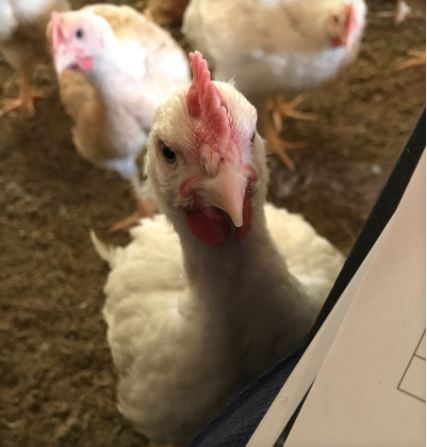



Study by FAI Farms and partners finds slower growing chickens experience higher welfare
First study to highlight welfare differences between fast and slower growing broilers in a commercial setting using welfare indicators
The study carried out by researchers from FAI Farms, the University of Bristol and The Norwegian University of Life Sciences was published 16 September in Scientific Reports.
The majority of broilers produced for consumption are considered conventional, fast-growing breeds. This study is the first to highlight the welfare differences between fast and slower growing broilers in a commercial setting utilising a comprehensive suite of positive and negative welfare indicators. The authors conclude that, while there are benefits of providing chickens with more space – by slightly lowering the animal density, changing to a slower growing breed results in much better health and more positive experiences for these birds.
“Broilers are motivated to perform a range of positive behaviours. These positive behaviours create positive experiences, resulting in enjoyment or pleasure. Displaying positive behaviours improves an animal’s quality of life. Our seminal study found slow growing birds to have better health and perform more positive behaviours than conventional fast growing broilers. A shift away from fast-growing breeds would provide the most significant improvement for the lives of the 142 million chickens produced in Europe every week," said Annie Rayner, FAI’s lead researcher.
Dr Siobhan Mullan, Senior Research Fellow in Animal Welfare at the Bristol Vet School, added: “This first independent commercial scale trial provides robust evidence of the health and welfare benefits of slower growing breeds of chicken. We hope that it will help to drive changes in supply chains and large companies to bring about real improvements to chicken welfare.”

The NGO-backed European Chicken Commitment (ECC) has attracted widespread attention from commercial broiler production with several major brands already having signed up - including KFC, Nestle, M&S and Nando’s. This study set out to interrogate the commercial welfare implications of two critical aspects of the commitment – a move to slower growing breeds and lowering the stocking density.
The commercial-scale farm trial explored a comprehensive suite of positive and negative welfare indicators in four production systems varying in stocking density and breed. One slower growing breed (the slowest) was stocked at a planned maximum density of 30 kg/m2, a second slower growing breed at planned densities of 30 kg/m2 and 34 kg/m2, and the welfare outcomes were compared to those of a standard fast-growing breed stocked at 34kg/m2.
At the lower density, the slowest growing breed was found to have slightly better welfare than the other slower growing breed - as indicated by lower mortality, fewer rejections at processing and better walking ability. Differences in welfare of the slower growing breed stocked at two densities were small. However, prominent differences were found between the standard fast-growing birds stocked at 34kg/m2 and birds in the three other systems. The standard birds experienced poorer health as indicated by higher levels of mortality, hock burn and pododermatitis as well as greater rejections at processing. Furthermore, the conventional birds showed less perching on enrichment bales as well as fewer positive ‘play’ and ‘exploration’ behaviours.
Professor Ruth Newberry and Dr Judit Vas at The Norwegian University of Life Sciences Faculty of Biosciences point to the importance of including indicators of positive experiences in animal welfare studies.
“Until recently, play was hardly ever mentioned in studies of chickens. We found that, when you walk through a commercial flock, you just have to turn around and look behind you to see chickens frolicking in your footsteps. This was especially the case in the slower growing flocks,” noted Newberry and Vas.
Paper








